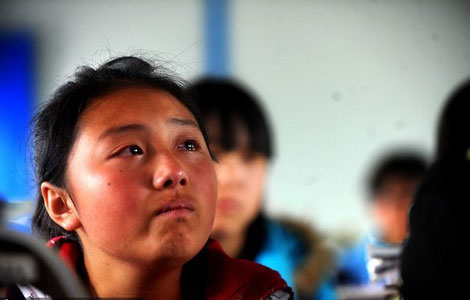Domestic pig breeds at risk of dying out
Updated: 2013-07-08 07:12
By An Baijie in Beijing and Zhou Wenting in Shanghai (China Daily)
|
|||||||||||
The most-common breeds are Yorkshire and Berkshire, both from Britain; Landrace, which originated in Denmark; and Duroc, from the United States.
Many are also hybrid species. In May, a Shanghai company paid 20 million yuan ($3.26 million) for 865 "high-end custom swine" from the US, the highest amount ever paid for an imported breed.
For farmers, the decision to switch to foreign pigs comes down to simple economics: Compared to native species, they grow faster, have a better fat-to-meat ratio and yield higher returns.
"The proportion of lean meat for a native breed is 35 percent, while for a foreign breed it is 65 percent," said Han Xuejun, general manager of Shanghai Xiangxin Livestock Poultry Co. "Excessive fat is not what people want today."
He said his company had visited six farms in the US over the past two years to select pigs in the top 20 percent in terms of quality out of the 1.5 million on the US National Swine Registry.
More lean meat also means higher profits for meat-processing companies, said An Baoshou, a livestock trader in Shandong's Zhucheng city.
The cost of keeping a native pig is roughly double that for an import, which is about 14 yuan per kilogram.
"Pig farmers look at market demand and are driven by profits," said Yang Zhenxi, secretary-general of the Shanghai Swine Trade Association. "They won't keep native varieties if no one is willing to pay a higher price for the meat."
However, he added that he feels the industry has taken the easy option of importing animals rather than investing time and money into nurturing native breeds.
"The overriding problem is that no one in the industry or in government is willing to do realistic research to improve Chinese breeds," he said. "It takes time to carry out scientific research, and the effects are often slow in coming.
"People think it's more convenient to just bring in what others have done."
Instead of developing native breeds, Yang said, the country's measures are akin to those used to protect pandas. For example, he said, the government spends millions of yuan to ensure the survival of 10 boars and 100 sows in each of Shanghai's five native varieties.
"These breeds are not for sale at any price," he said. "Yet the offspring they produce is coming from a very small population, which is not conducive to the species' health or development."
Academics also agree that the failure to use imported breeds to develop the genetic code of Chinese species is a missed opportunity.
Pan Yuchun, a professor at Shanghai Jiao Tong University's School of Agriculture and Biology, is among those suggesting urgent reforms.
"If we import a breed but don't cultivate it, we'll simply have a cycle of introduction and degradation, no matter how prized the breed," he said. "The key objective of importing breeds should be so they can play a role in boosting the genetic system of our species."
Related Stories
Pork firm deal to help restore consumer trust 2013-06-15 07:54
Shuanghui to buy US pork producer 2013-05-31 13:57
Shuanghui acquires world's largest pork processor 2013-05-30 01:14
China's pork price rebounds after government boost 2013-05-23 09:54
Today's Top News
Train derails in southwest Russia, 7 injured
Testing fresh ground for clean tech development
Boeing 777 passenger 'mumbled a prayer'
Job seekers should be cautious abroad
Ex-minister gets suspended death
River pollution sparks criticism
Chinese workers return after dispute
Terror attack was planned: suspect
Hot Topics
Lunar probe , China growth forecasts, Emission rules get tougher, China seen through 'colored lens', International board,
Editor's Picks

|

|

|

|

|

|





